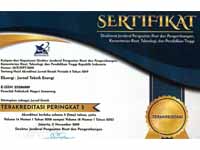Energy Audit of Flouresen Lights at School Building C III Floor Politeknik Negeri Semarang
DOI:
https://doi.org/10.32497/eksergi.v18i3.3890Keywords:
Energy audit, electrical energyAbstract
Energy audit is very necessary to calculate the level of energy consumption of a building or buildings. The research includes the amount of energy consumption based on the initial energy audit and detailed energy audit as well as saving opportunities based on conditions in the field. Based on the initial energy audit, the value of the Energy Consumption Intensity (IKE) is 0.699 kWH/m2month, while in the detailed audit the IKE value is 0.935 kWH/m2month. Based on the results of a detailed energy audit, the lighting measurement of 325 lux still meets the requirements for a classroom with a standard between 250 lux to 500 lux.
References
“Audit Energi Untuk Mencapai Peluang Penghematan Energi”. Jurnal Teknologi Vol. 7, No. 1 Januari 2017. ISSN 2088-3315.
Muhamad Aris Raharjo dan Selamet Riadi. “Audit Konsumsi Energi Untuk Mengetahui Peluang Penghematan Energi Pada Gedung PT INDONESIA CAPS AND CLOSURES”. Jurnal PASTI Volume X No. 3, 342 - 356.
Babu, Manjunatha. “Energy Audit, Conservation And Power Factor Improvement For BMSIT Campus”. International Journal of Research Engineering and Technology, Vol.1
No.1. 2013.
Malik, Abdul. “Audit Energi Pada Gedung IV Kantor PT PLN (PERSERO) Wilayah Kalimantan Barat”. Jurnal ELKHA Vol.5, No.2. 2013.
Untoro, Jati. Audit Energi dan Analisa Penghematan Konsumsi Energi pada Peralatan Listrik di Gedung Pelayanan Unida. Jurnal Rekayasa dan Teknologi Elektro Vol 8, No.2. 2014.
Agung Wahyudi dan Dadang S. Permana. “Analisis Audit Energi Untuk Pencapaian Efisiensi Energi Di Gedung AB, Kabupaten Tangerang, Banten”. Jurnal Teknik Mesin (JTM), Vol. 06, 2017.
Purbaningrum, Sanurya Putri. "Audit energi dan analisis peluang penghematan konsumsi energi listrik pada rumah tangga." Jurnal Media Mesin, Vol. 15, No. 1, januari 2014, hal. 26 ”“ 33.
Biantoro, Agung Wahyudi, and Dadang S. Permana. "Analisis AuditEnergi untu Pencapaian Efisiensi Energi di Gedung Ab, Kabupaten Tangerang, Banten." Jurnal Teknik Mesin Mercu Buana 6.2 (2017): 85-93.
Marzuki, Achmad. "Audit Energi pada Bangunan Gedung Direksi PT. Perkebunan Nusantara XIII (Persero)." Vokasi, Volume 8, Nomor 3, Oktober 2012. hal 184 ”“ 196.
Mulyani, Fajariyah, Hadi Suyono, and Rini Nur Hassanah. "Audit dan Rancangan Implementasi Sistem Manajemen Energi berbasis ISO 50001 di Universitas Brawijaya Malang." Jurnal EECCIS 12.2 (2018): 78-84.
Rahayu, Nirita Noviyati. "Audit Energi Listrik Pada PT. X." Jurnal Online Mahasiswa (JOM) Bidang Teknik Elektro 1.1 (2016): 1-9.
Purwito, Purwito, Tadjuddin Tadjuddin, and Akbar Akbar. "Audit Energi dan Analisis Peluang Penghematan Energi di PT. Daikin Air Conditioning Makassar." INTEK: Jurnal
Penelitian 5.2 (2018): 115-121.
Marzuki, Achmad. "Audit Energi pada Bangunan Gedung Direksi PT. Perkebunan Nusantara XIII (Persero)." Vokasi, Volume 8, Nomor 3, Oktober 2012. hal 184 ”“ 196.
Jamal, Marlina, Floransya Dwi. “Audit Energi dan Analisis Peluang Penghematan Energi Listrik Pada Bagian Produksi di PT. EPFM Makassar”. Sinergi No. 1, Tahun 17, April 2019.
M. Ikhsan and M. Saputra, "Audit Energi Sebagai Upaya Proses Efisiensi Pemakaian Energi Listrik Di Kampus Universitas Teuku Umar (UTU) Meulaboh," Jurnal Mekanova, vol. 2,
no. 3, pp. 136-146, 2016.
F. Hazrina, V. Prasetia and A. A. Musyafiq, "Audit dan Analisis Penghematan Energi Sistem Tata Cahaya Gedung E dan F (Studi Kasus di Politeknik Negeri Cilacap)," Jurnal
ECOTIPE, vol. 7, no. 1, pp. 12-19, April 2020.
Downloads
Published
Issue
Section
License
Authors who publish with this journal agree to the following terms:Authors retain copyright and grant the journal right of first publication with the work simultaneously licensed under a Creative Commons Attribution License that allows others to share the work with an acknowledgement of the work's authorship and initial publication in this journal.
Authors are able to enter into separate, additional contractual arrangements for the non-exclusive distribution of the journal's published version of the work (e.g., post it to an institutional repository or publish it in a book), with an acknowledgement of its initial publication in this journal.
Authors are permitted and encouraged to post their work online (e.g., in institutional repositories or on their website) prior to and during the submission process, as it can lead to productive exchanges, as well as earlier and greater citation of published work (See The Effect of Open Access).






